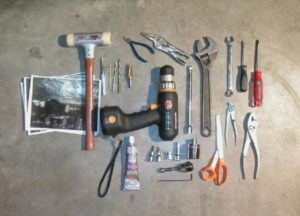TOOLS USED IN FITTING SHOP
Tools used in bench and fitting shop are classified as under.
1. Marking tools
2. Measuring devices
3. Measuring instruments
4. Supporting tools
5. Holding tools
6. Striking tools
7. Cutting tools
8. Tightening tools, and
9. Miscellaneous tools
The above mentioned tools are further classified and discussed as under.
1. Markeing Tools
These are sub classified as steel rule, circumference rule, straight edge, flat steel square, scriber, semi-circular protractor, divider, trammel, prick punch, centre punch, try square, bevel square, vernier protractor, combination set and surface gauge.
2. Measuring Devices
Commonly used measuring devices and instruments used in bench and fitting shop are fillet and radius gauge, screw pitch gauge, surface plate, try square, dial gauge, feeler gauge, plate gauge and wire gauge.
3. Measuring Instruments
Line measuring and end measuring devices. While using line measuring device, the ends of a dimension being measured are aligned with the graduations of the scale from which the length is read directly such as scales or steel rules. Whereas, with end measuring device, the measurement is taken between two ends as in a micrometer, vernier calipers and gauge block, etc. End measuring devices are commonly used for measuring accurate and precision dimensions of components. Some measuring instruments are employed for measuring linear dimensions and others are suitable for determining angular or geometric dimensions. Few measuring instruments are also kept for reference purposes as standards of comparison. The main measuring instruments are listed as under.
(i) Linear measurements
(A) Non-precision instruments
1. Steel rule
2. Calipers
3. Dividers
4. Telescopic gauge
5. Depth gauge
(B) Precision instruments
1. Micrometers
2. Vernier calipers
3. Vernier depth gauges
4. Vernier height gauges
5. Slip gauges
(C) Comparators
(D) Coordinate measuring machines
(ii) Angular measurements
(A) Non-precision instruments
1. Protector
2. Engineers square
3. Adjustable bevel
4. Combination set
(B) Precision instruments
1. Bevel protector
2. Angle gauges
3. Sine bar
4. Clinometers
5. Autocollimators
6. Sprit level
(iii) Surface measurement
1. Straight edge
2. Surface gauge
3. Surface table
4. Optical flat
5. Profilo-meter
4. Supporting Tools
These are vee-block, marking table, surface plate, and angle plate.
5. Holding Tools
These are vices and clamps. Various types of vices are used for different purposes. They include hand vice, bench vice, leg vice, pipe vice, and pin vice. The clamps are also of different types such as c or g clamp, plane slot, goose neck, double end finger, u-clamp, parallel jaw, and clamping block.
6. Strking Tools
These are various types of hammers such as ball peen hammer; straight peen hammer; cross-peen hammer; double face hammer; soft face hammer.
7. Cutting Tools
These involve various types of files, scrapers, chisels, drills, reamers, taps, snip or shear and hacksaws.
Files. There are different types of files such as flat, square, round, triangular, knife, pillar, needle and mill.
Scrapers. These are flat, hook, triangular, half round types.
Chisels. There are different types of chisels used in fitting work such as flat chisel, cross cut chisel, diamond point chisel, half round chisel, cow mouth chisel and side cutting chisel.
The other cutting tools are drills, reamers, taps, snips, hacksaws (hand hacksaw and power hacksaw) etc.
8. Tightening Tools
These are pliers and wrenches, which are sub classified as under.
Pliers. These are namely ordinary, needle nose, and special type.
Wrench. These are open single ended, open double ended, closed ended adjustable, ring spanner, offset socket, t- socket, box wrench, pipe wrench and allen wrench.
9. Miscellaneous Tools
These are die, drifts, counter sink tools, counter boring tools, spot facing bit and drill press. Some of above mentioned important tools are discussed as under. Source A Textbook of Basic Manufacturing Processes and Workshop Technology by Rajender Singh.













Post Comment
You must be logged in to post a comment.